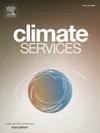Bridging the communication gap in agrometeorological services: Enhancing the uptake and effectiveness for users in developing countries
IF 4
3区 环境科学与生态学
Q2 ENVIRONMENTAL SCIENCES
引用次数: 0
Abstract
Over the past decades, advancements in agrometeorological monitoring and forecasting have been driven by technology, infrastructure, and capacity building. Literature highlights that agrometeorological services support agricultural decision-making, boosting farmers’ resilience and income globally. However, challenges in communication and dissemination limit their effectiveness, particularly for smallholder farmers in remote areas. The problem extends beyond media type and format to issues of accessibility, comprehensibility, and users’ trust. While technology has enabled faster dissemination, there is a risk of new services being technology-centered rather than user-focused. This non-systematic literature review delves into effective communication strategies for agrometeorological information in developing countries, reviewing existing knowledge and presenting case studies. It addresses how to ensure access to information, identify efficient communication channels, use inclusive technologies, enhance users’ understanding, make information actionable, and gather feedback on information effectiveness. Stakeholders’ engagement methods include a variety of participatory approaches and iterative monitoring, evaluation and learning processes. The choice of communication channels significantly affects information reach. Despite the rise of ICT, challenges in access and understanding persist, especially for marginalized groups, making simple communication technologies like rural radios still crucial for last-mile dissemination. The review emphasizes that no single communication approach fits all situations. Key principles of coproduction and user engagement in climate services are essential for effective agrometeorological communication. Future directions include enhancing the legitimacy and salience of services by integrating local knowledge, expanding scope to include herders and off-farm stakeholders, building capacity among intermediaries and users, soliciting feedback, and fostering public–private partnerships for scaling and sustainability.

弥合农业气象服务的沟通差距:提高发展中国家用户的吸收和有效性
在过去的几十年里,农业气象监测和预报的进步是由技术、基础设施和能力建设推动的。文献强调,农业气象服务支持农业决策,提高全球农民的抵御能力和收入。然而,沟通和传播方面的挑战限制了它们的有效性,特别是对偏远地区的小农。这个问题超出了媒体类型和格式,还涉及到可访问性、可理解性和用户信任等问题。虽然技术使传播速度更快,但新服务有以技术为中心而不是以用户为中心的风险。这篇非系统的文献综述深入研究了发展中国家农业气象信息的有效传播策略,回顾了现有知识并提出了案例研究。它涉及如何确保获取信息、确定有效的沟通渠道、使用包容性技术、增强用户理解、使信息具有可操作性以及收集关于信息有效性的反馈。利益相关者的参与方法包括各种参与方法和迭代监测、评估和学习过程。传播渠道的选择对信息的到达有显著影响。尽管信息通信技术兴起,但获取和理解方面的挑战仍然存在,尤其是对边缘化群体而言,这使得农村无线电等简单的通信技术对于最后一英里的传播仍然至关重要。审查强调,没有一种沟通方法适合所有情况。气候服务合作生产和用户参与的关键原则对于有效的农业气象通信至关重要。未来的方向包括通过整合当地知识、扩大范围以纳入牧民和非农利益相关者、建设中介机构和用户的能力、征求反馈以及促进公私伙伴关系以扩大规模和可持续性来提高服务的合法性和突出性。
本文章由计算机程序翻译,如有差异,请以英文原文为准。
求助全文
约1分钟内获得全文
求助全文
来源期刊

Climate Services
Multiple-
CiteScore
5.30
自引率
15.60%
发文量
62
期刊介绍:
The journal Climate Services publishes research with a focus on science-based and user-specific climate information underpinning climate services, ultimately to assist society to adapt to climate change. Climate Services brings science and practice closer together. The journal addresses both researchers in the field of climate service research, and stakeholders and practitioners interested in or already applying climate services. It serves as a means of communication, dialogue and exchange between researchers and stakeholders. Climate services pioneers novel research areas that directly refer to how climate information can be applied in methodologies and tools for adaptation to climate change. It publishes best practice examples, case studies as well as theories, methods and data analysis with a clear connection to climate services. The focus of the published work is often multi-disciplinary, case-specific, tailored to specific sectors and strongly application-oriented. To offer a suitable outlet for such studies, Climate Services journal introduced a new section in the research article type. The research article contains a classical scientific part as well as a section with easily understandable practical implications for policy makers and practitioners. The journal''s focus is on the use and usability of climate information for adaptation purposes underpinning climate services.
 求助内容:
求助内容: 应助结果提醒方式:
应助结果提醒方式:


